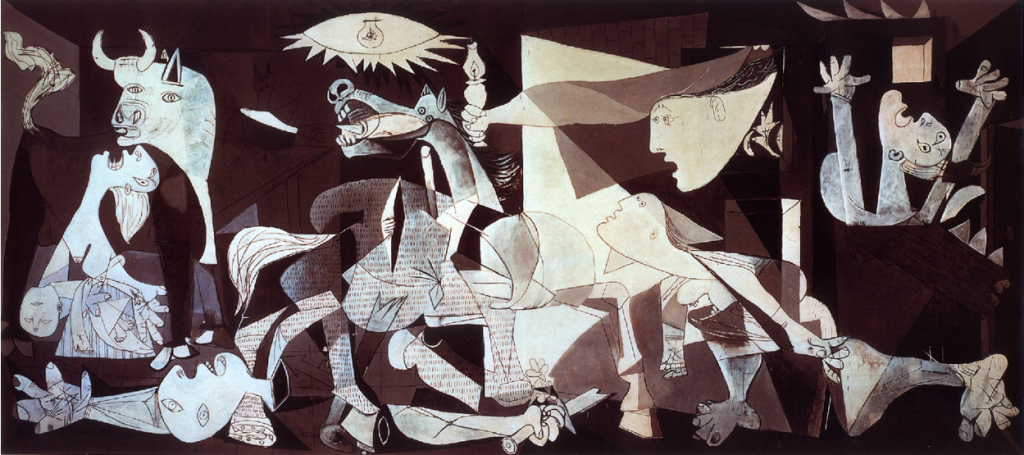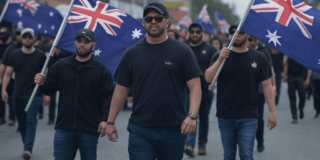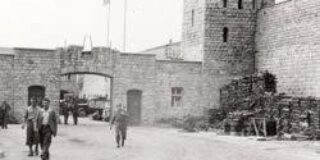
This morning, I found myself nestled in my studio in Sydney, gazing out at the vast Pacific Ocean, its waves crashing against the shores of Bondi like a relentless artist painting a tumultuous masterpiece. Overhead, gulls swooped gracefully, their cries cutting through the salty air. In my hand, I cradled a Guernica coffee mug, a cherished gift from Aitor, a Basque comrade from my radical days in Berlin. Its chipped surface, emblazoned with Picasso’s anguished masterpiece, anchored me to a time when I passionately marched through the streets of Berlin, convinced that the world could be reshaped for the better. As I took a sip from the mug, my thoughts drifted back to April 26, 1937, the day Guernica was obliterated by bombs, and then to the ongoing devastation in Gaza, a tragedy unfolding in real time and captured through the poignant social media posts of Palestinian photo-journalist Motaz Azaiza.
The bombing of Guernica and the war in Gaza, though separated by nearly a century, resonate with the universal language of suffering, shaped by distinct historical, political, and cultural forces. In this essay, I will explore the parallels and divergences between these two tragedies, reflect on my personal journey from a firebrand in Berlin to a reflective observer in Sydney, and examine the transformative role of media coverage in amplifying their stories. Azaiza’s innovative social media strategies serve as a powerful lens through which we can confront these tragedies and find pathways for action.
Guernica: A Town Transformed into an Eternal Symbol
On that fateful April afternoon in 1937, Guernica, a Basque market town in northern Spain, became the target of an unprecedented aerial assault. For three relentless hours, the skies roared with the engines of 60 German and Italian warplanes, as the Condor Legion, acting on behalf of Franco’s Nationalist forces during the Spanish Civil War, unleashed a torrent of incendiary bombs, high-explosive shells, and machine-gun fire. Orchestrated by German commander Wolfram von Richthofen, this calculated attack served as a harrowing experiment to gauge the Luftwaffe’s capacity for annihilating civilian populations. Guernica, chosen for its vulnerability, was caught in the throes of a market day, its residents lulled into a false sense of security. Estimates of the death toll range from 300 to 1,700, but the aftermath was clear: 70% of the town lay in ruins, fires raged for days, and survivors wandered through the charred remnants of their lives. This horrifying act of aerial terror foreshadowed the total war that would engulf the world in the coming years, shocking an unprepared global audience.
In my early 20s, living amidst the post-reunification fervour of Berlin, Guernica stood as a beacon of defiance. I first met Aitor in 1995 at an anti-fascist rally near Alexanderplatz, where the atmosphere crackled with urgency and a shared sense of purpose. His grandmother’s harrowing tale – of hiding in a ditch while the sky above her burned – seared itself into my consciousness, made visceral by Germany’s own reckoning with its Nazi past. When I returned to Australia, Aitor gifted me the Guernica mug, his parting words echoing in my ears, “Art screams what we cannot.” I carried that mug to protests, its weight in my backpack a talisman against despair. Picasso’s Guernica, a towering 25-foot canvas of jagged screams and shattered bodies, unveiled at the 1937 Paris Exposition, became my manifesto. Its stark lightbulb, symbolising mechanised destruction, spoke to me in Berlin, where the scars of history urged me to take action. Now, in my 50s, in my Sydney studio overlooking the Pacific, the mug’s cracks mirror my doubts, intensified by the relentless agony unfolding in Gaza.
Gaza: A Protracted Tragedy in a Digital Age
Fast forward to October 7, 2023, when Hamas, a Palestinian militant group designated as terrorists by Israel, the United States, and others, launched “Operation Al-Aqsa Flood.” They fired thousands of rockets, breached Israel’s border, and claimed the lives of over 1,200 civilians while taking 254 hostages, including women and children. Rooted in decades of Israeli-Palestinian conflict – marked by the 1948 Nakba, ongoing occupation, and the blockade of Gaza since 2007 – the attack was framed by Hamas as a desperate act of resistance against Israel’s oppressive policies, including restrictions on Gaza and escalating tensions surrounding Jerusalem’s Al-Aqsa Mosque. Israel’s response was swift and overwhelming: airstrikes targeted Hamas positions, often striking densely populated areas, followed by a ground invasion aimed at dismantling Hamas’s capabilities and securing the hostages. As of May 17, 2025, the war continues to ravage Gaza’s 2.3 million residents, confined within a mere 140-square-mile enclave. The Gaza Health Ministry reports over 40,000 deaths, although Israel contests these figures, arguing that many casualties are combatants. Entire neighbourhoods lie in ruins, hospitals are overwhelmed, and Hamas persists with rocket attacks, perpetuating a cycle of violence that seems unending.
The suffering in Gaza resonates with me in ways that the tragedy of Guernica, powerful as it is, never could. In my days in Berlin, I would have joined pro-Palestine marches, my voice hoarse from chanting for justice. Now, settled in the comfortable embrace of Sydney’s Eastern Suburbs, where the yachts of Rose Bay bob serenely and the cafés of Double Bay hum with life, I find myself a father, my once-radical fire tempered by the demands of life and the sobering realisation that protests have not halted the bombs. I watch Gaza’s destruction unfold on my phone: posts on X, clips on ABC and SBS, a father cradling his lifeless child, a hospital roof collapsing in on itself. My daughter’s laughter fills my studio, and I am haunted by the thought of her in Gaza, her joy extinguished by the relentless violence. The Guernica mug, once a symbol of action and defiance, now feels like a rebuke: why am I merely a spectator, watching from my privileged vantage point in Sydney’s affluent bubble? The turquoise beauty of the Pacific, mere steps from my home, mocks my inertia, urging me to move beyond sipping coffee and scrolling through social media.
Parallels: The Universal Language of Suffering
The bombing of Guernica and the ongoing war in Gaza, though separated by time and context, share haunting parallels that underscore the timeless brutality of war. Both tragedies involved aerial assaults that transformed vibrant communities into desolate landscapes of ruin. Guernica’s bustling market square, once alive with farmers and children, became a killing field; Gaza’s residential blocks, schools, and mosques now lie in ruins, their former vibrancy extinguished. I envision the vendors of Guernica and the shopkeepers of Gaza, both immersed in their daily lives before violence rewrote their fates. The gulls soaring outside my window, indifferent to human suffering, serve as a stark reminder of our vulnerability – despite our advancements, we remain prey to our own destructive tendencies.
The psychological toll of these events is another shared thread. Survivors of Guernica spoke of the harrowing shrieks of dive-bombers and the acrid stench of burning flesh. In Gaza, residents describe the constant drone of surveillance and the terror of airstrikes striking without warning. Aitor’s grandmother carried her trauma into old age, her nightmares vivid in his retellings; I see the same hollowed gazes in Gaza’s children as they appear on my screen, their innocence shattered. As a father, I cannot unsee my daughter in their faces, her safety a stark privilege in Sydney’s Eastern Suburbs, where the horrors of war feel a world away. This shared trauma transcends time, measuring the cost of war in fractured lives and stolen futures.
Both tragedies also reflect strategic intent. The bombing of Guernica was a fascist experiment designed to crush Basque resistance and signal global dominance, a chilling rehearsal for larger conflicts. Israel’s campaign in Gaza, while framed as a defensive response to Hamas’s aggression, has been criticised by human rights organisations as a form of collective punishment, aimed at deterring future militancy by imposing devastating costs on Gaza’s civilian population. In my days in Berlin, I saw oppressors and oppressed in clear terms, chanting against militarism. Now, I grapple with the complexities – Hamas’s brutal October 7 attack, Israel’s disproportionate retaliation, and the civilians caught in the crossfire. The outcome – lives extinguished, communities erased – remains tragically consistent, prompting me to question why humanity continues to repeat such cycles of destruction.
Divergences: Historical Context and Modern Complexities
Despite their many parallels, Guernica and Gaza diverge profoundly, shaped by their unique historical and political contexts. The bombing of Guernica was a singular, three-hour cataclysm, its perpetrators, German and Italian pilots, detached from the local population and driven by the ambitions of fascist geopolitics. In contrast, Gaza’s ordeal represents a protracted chapter in a conflict that stretches back to the 1948 Nakba, layered with territorial disputes, religious tensions, and mutual grievances. This enduring struggle weighs heavily on me. In my 20s, I believed in swift victories – end a war, topple a regime. Gaza’s blockade, repeated military operations, and entrenched divisions now mock that youthful optimism. My life in Sydney, filled with yoga studios and waterfront cafés, feels complicit against Gazans who ration water, the cracks in my mug mirroring my faded activism, now reduced to donations and retweets.
The nature of the belligerents further distinguishes the two. Guernica’s attackers were foreign forces, their motives tied to global fascist ambitions. In contrast, Gaza’s conflict is intimate yet asymmetrical: Israel, a sovereign state equipped with advanced military technology, faces Hamas, a non-state actor embedded within Gaza’s civilian population. This dynamic complicates Israel’s operations, as Hamas’s use of civilian areas blurs the lines between combatants and non-combatants, a challenge absent in the straightforward aerial annihilation of Guernica. In Berlin, I would have unequivocally supported Palestine, marching with banners held high. Now, in Sydney’s multicultural tapestry – where Lebanese, Jewish, and Palestinian communities voice competing truths – I find myself faltering. Suffering transcends sides, yet solutions seem elusive, echoing Australia’s own complex history of Indigenous dispossession and ongoing reconciliation debates.
Technology marks another stark contrast between the two tragedies. The bombing of Guernica represented a novel tactic in 1937, its scale shocking and unprecedented. In Gaza, the war employs drones, AI-guided munitions, and rockets, yet the outcome – civilian deaths – feels achingly familiar. In Berlin, I distributed leaflets, believing that information was power. Now, in Sydney, I see images of Gaza’s dead on X, their faces liked or ignored, and I wonder if we have traded genuine compassion for digital clicks. The physical distance from the conflict, set against the backdrop of Bondi’s surf and Vaucluse’s mansions, amplifies my guilt – I am a spectator, not a participant, in a world where technology both reveals and numbs.
The Role of Media Coverage: From Unified Outrage to Fragmented Narratives
Media coverage serves as a critical lens for understanding the narratives of Guernica and Gaza, shaping their legacies and influencing my own response. In 1937, British journalist George Lowther Steer’s dispatch in The Times – “Guernica, the most ancient town of the Basques… was completely destroyed” – reached global audiences, including readers of Australia’s Sydney Morning Herald. Published mere days after the bombing, Steer’s vivid account of civilian slaughter at the hands of fascist forces galvanised international condemnation, amplified by the power of print, radio, and newsreels. His reporting, which risked censorship from Franco’s regime, rallied anti-fascist sentiment and solidified Guernica’s status as a symbol of war’s atrocities. Picasso’s Guernica, unveiled at the 1937 Paris Exposition, extended this outrage, its monochromatic screams serving as a visual echo of Steer’s words. In Berlin, as I studied Germany’s reckoning with its past, I envied this era’s clarity – media told a story, and the world listened, compelling me to act.
In stark contrast, Gaza’s media landscape presents a paradox of abundance and fragmentation. Since October 7, 2023, smartphones, drones, and 24/7 news coverage have captured every airstrike, rocket, and tear. Australian outlets like ABC and SBS, alongside Al Jazeera and CNN, broadcast live updates, while citizen footage floods social media platforms like X and Instagram. This immediacy – Gaza’s pain reaching my phone in Sydney within minutes – contrasts sharply with the delayed reports following Guernica’s destruction. Yet, the polarised narratives surrounding the Israeli-Palestinian conflict dilute the impact of this coverage. On X, hashtags like #FreePalestine clash with #StandWithIsrael, each side sharing selective footage – Hamas’s rockets or the devastation of bombed hospitals. In Berlin, I would have joined pro-Palestine rallies, certain of the cause. Now, in Sydney’s diverse media ecosystem, algorithms feed my biases, clouding my understanding. Information is abundant, yet genuine comprehension feels elusive, leaving me feeling impotent amidst the affluence of Rose Bay.
The role of journalists in these two contexts underscores this shift. Steer faced censorship but not the mortal danger that Gaza’s journalists contend with daily. Over 179 journalists have been killed since October 2023, according to the Committee to Protect Journalists, many allegedly targeted by Israel in an effort to suppress Palestinian voices – a claim that Israel denies. Their posts on social media serve as lifelines to the world, including audiences in Sydney, yet I am shamed by my safety as I tweet support from my studio while they dodge bombs. The intersection of art and media also differs significantly. Picasso’s Guernica was a singular, enduring cry; Gaza’s artists – poets like Mosab Abu Toha, photographers like Mohammed Salem – struggle to make their work resonate amidst the cacophony of digital noise, their creations trending briefly before fading into obscurity amidst the distractions of life in Double Bay. This fragmentation, unlike the unified outrage surrounding Guernica, challenges my resolve to remain engaged.
Motaz Azaiza’s Social Media Strategies: A Modern Voice for Gaza
Motaz Azaiza, a 25-year-old Palestinian photojournalist born in Gaza’s Deir al-Balah Camp, has emerged as a vital voice for Gaza, witnessing his Instagram following soar from 25,000 to over 18 million by January 2024. His innovative social media strategies fill the gaps left by Israel’s restrictions on foreign journalists, amplifying Gaza’s plight in ways that Steer’s reporting never could, yet they also face unique modern challenges. Below, I outline Azaiza’s key strategies, their impact, and their resonance with my personal journey.
1. Unfiltered Visual Storytelling: Azaiza’s raw images and videos – depicting children buried in rubble, families grieving – cut through the sanitised narratives often presented by traditional media. His haunting 2023 Time photo of a girl trapped in Al-Nuseirat, captured with low-shutter-speed for dramatic effect, serves as a digital equivalent of Picasso’s Guernica, conveying the brutality of war in a single frame. Unlike traditional media, his posts are unpolished and immediate, resonating with a young audience craving authenticity. In Berlin, I would have pinned protest posters for impact; Azaiza’s images are digital posters, reaching millions instantly, their urgency piercing through my complacency in Sydney.
2. Personal Engagement and Emotional Bonding: Azaiza turns the camera on himself, sharing his fear, grief, and resilience – rushing bloodied infants to hospitals, caressing lifeless limbs while choking back tears. His captions, such as “I risked my life to show you everything I’ve found,” forge a deep bond with his followers, inviting them into his world. His post on November 20, 2023, which noted the staggering number of child deaths on World Children’s Day, sparked viral hashtags, ensuring his voice was heard even when his posts lagged. From my safe studio in Sydney, his haunted gaze on social media makes Gaza’s distant suffering immediate, stirring the activist fire I thought had long been extinguished.
3. Rapid Response to Censorship and Threats: Facing Instagram suspensions (such as on October 13, 2023, after posting about his family’s deaths) and threatening calls warning him that his footage could cost him his life, Azaiza created a backup account, @Motagaza, which gained 1 million followers within 24 hours. He utilises X to counter misinformation, including refuting claims that he blamed Hamas for child deaths. His resilience – losing 15 relatives in an airstrike – mirrors the experiences of Guernica’s survivors, humbling me as I tweet from my secure studio.
4. Global Advocacy Through Digital Reach: After evacuating to Qatar in January 2024, Azaiza embarked on a “Gaza Through My Lens” tour with UNRWA USA, delivering talks at prestigious institutions such as Harvard and Columbia, and making appearances on platforms like Democracy Now! and BBC’s HARDTalk. His efforts raised over $800,000 for Gaza’s displaced population. Unlike my Berlin rallies, which were limited to physical gatherings, Azaiza’s dual digital-physical strategy inspires global action, serving as a model I wish I had known in my youth.
5. Nuanced Advocacy for Broad Appeal: Azaiza critiques Israel with statements like “Stop killing us,” while skilfully sidestepping Hamas’s role, broadening his appeal. A post from March 2024, which hinted at potential criticism of Hamas, sparked division among his followers, highlighting the delicate balance he maintains. This nuance challenges my perspective in Sydney, where multicultural debates – encompassing Lebanese, Jewish, and Palestinian voices – reflect the complexities of the issue. In Berlin, I viewed matters in black-and-white; Azaiza navigates the grey areas, urging me to engage thoughtfully.
6. Leveraging Viral Moments and Collaborations: Azaiza’s viral posts, such as his removal of a press jacket before evacuating, accompanied by a plea to “Pray for Gaza,” garnered millions of views. Collaborations with peers, like Hind Khoudary, who labelled him a “unique mark,” and a viral photo with Warl Al-Dahdouh symbolise resilience. His clips, viewed up to 70 million times, drive protests in a way that my chants in Berlin could never achieve.
Azaiza’s impact is profound. His inclusion in Time’s 100 list, designation as GQ Middle East’s “Man of the Year,” and nomination for the Nobel Peace Prize reflect his role as “Gaza’s window,” according to The New Arab. His posts, which fill the gaps left by Israel’s journalist ban, inspire protests, university encampments, and billions of views on TikTok and X. Yet, he laments to CNN, “Nothing changed,” as the digital noise – memes, misinformation – and polarisation (such as the May 2025 claim from @HonestReporting that he glorified Hamas) dilute the impact of his efforts. His fundraising achievements and advocacy tours demonstrate tangible results, yet the deaths of 179 journalists, including friends, underscore the heavy cost of this struggle.
Personal Reflections: From Berlin’s Fire to Sydney’s Witness
As I hold my Guernica mug, tracing its cracks, I confront the evolution of my beliefs and actions. In Berlin, Aitor’s stories fuelled my marches, Germany’s Luftwaffe legacy making Guernica feel visceral and immediate. At 23, I was certain that revolution was possible, chanting against militarism alongside my comrades. Now, the war in Gaza, amplified by Azaiza’s posts, exposes my retreat into complacency. Surrounded by mansions and Bondi’s surf, my daughter’s laughter contrasts starkly with Gaza’s grief. Azaiza’s images – a child in rubble, his trembling voice – pierce through my privilege, demanding that I ask myself: why am I merely scrolling through X in my comfort while he risks his life for the truth?
In my 20s, I saw the world in black-and-white; Azaiza’s nuanced perspective navigates the grey, challenging me amidst Sydney’s multicultural debates. Australia’s complex history of Indigenous dispossession echoes Gaza’s Nakba, urging me to take action. Yet, my activism has dwindled to retweets, a far cry from Aitor’s charge to fight for justice. Azaiza’s strategies – raw visuals, global tours – shame my inertia. If he can carry Gaza’s story to 18 million followers, then surely I can amplify his voice, perhaps even join a march in Sydney’s CBD.
The mug serves as a reminder of art’s enduring power. Picasso’s Guernica didn’t stop the Spanish Civil War, but its legacy endures. Azaiza’s posts, like Steer’s reports, demand that we see and engage with the suffering of others. In Berlin, I believed that a single image could change the world; in Sydney, Gaza’s art often drowns in the digital noise, and I find myself complicit, distracted by the brunches and bustle of my home. Yet Azaiza’s courage – losing family, dodging snipers – stirs me to action. Australia’s complex past teaches that acknowledgment is merely the first step; I can write, share, and act, honouring Aitor’s gift and responding to Gaza’s plea.
Conclusion: A Call to Act Beyond Awareness
The stories of Guernica and Gaza, bound by their shared experiences of destruction, diverge in their historical contexts, but converge in their urgent plea: do not look away. Guernica’s unified media coverage and Picasso’s art served as a warning against fascism; Gaza’s fragmented narratives, led by Azaiza’s innovative strategies, implore us to break the cycles of hate and violence. In Berlin, I would have stormed the streets, my mug raised high. Yet in Sydney’s Eastern Suburbs, tempered by doubt and reflection, I choose to witness – amplifying Azaiza’s voice and questioning my complacency. The media, from Steer’s dispatches to Azaiza’s poignant posts, shapes our understanding of truth, but it is our responsibility to act. The gulls soar, the Pacific crashes, and my coffee cools. The mug, warm in my hand, bridges the past and present, urging me to act from Sydney before another town becomes a symbol of our collective failure.




Stop genocide in Israel